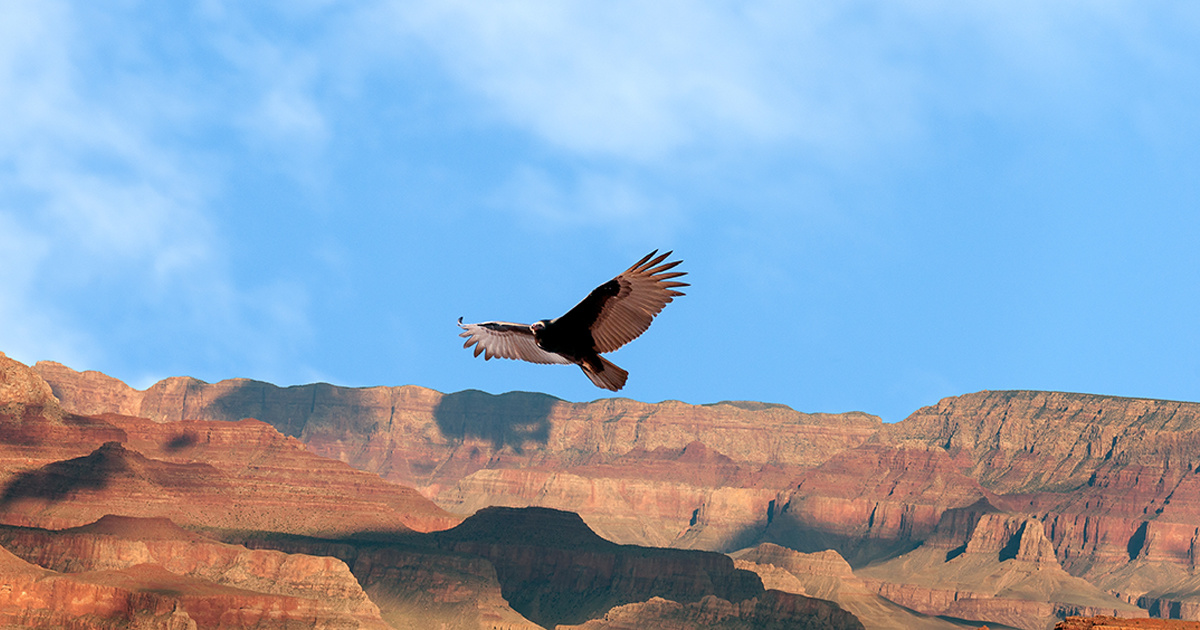
Birth of 1,000th California Condor Chick Is a Sign of Hope for This Critically Endangered Species

California Condor at soaring at the Grand Canyon. Pavliha / iStock / Getty Images
North America’s largest bird passed an important milestone this spring when the 1,000th California condor chick hatched since recovery efforts began, NPR reported Sunday.
The critically endangered species was down to just 22 birds in the early 1980s, according to The Guardian. The remaining birds were placed in a captive breeding program in 1987 and slowly reintroduced beginning in the early 1990s. The birth of the 1,000th bird highlights the success of this program in saving the species from extinction.
“We’re seeing more chicks born in the wild than we ever have before,” Peregrine Fund condor program manager Tim Hauck told NPR’s Scott Simon. “And that’s just a step towards success for the condor and achieving a sustainable population.”
The California Condor Recovery Program just confirmed its 1000th chick! This is the mood at our breeding center pic.twitter.com/KmVI4NAmCY
— Oregon Zoo (@OregonZoo) July 12, 2019
There are now more than 500 California condors alive worldwide, with more than 300 of them in the wild, Hauck said.
The 1,000th chick was born in Utah’s Zion National Park, park biologists announced July 9. The egg was likely laid in March, and the new baby emerged in May. But scientists were only able to confirm the birth in July because condors, like other raptors, build their nests in steep cliffs, Zion biologist Janice Stroud-Settles explained to The Guardian. Researchers had to rappel off a cliff across from the nest to snap a photo of the new baby.
“When we confirmed it … it was just this feeling of overwhelming joy,” Stroud-Settles said.
Congrats to recovery program partners and wildlife advocates everywhere on reaching 1,000 California condor chicks! This incredible milestone is the result of decades of collaboration and the power of the Endangered Species Act. Let’s keep protecting the laws that save wildlife. pic.twitter.com/vFdTQJuuul
— Don Moore PhD (@drdonmooreiii) July 12, 2019
The birth of a 1,001st chick was also confirmed this month in a nest near the north rim of the Grand Canyon, according to The Guardian.
The condor population was decimated during the 20th century due to hunting, habitat loss and lead poisoning from bullets left in the dead animals the condors would scavenge for food. Lead bullets still pose a threat; the mother of the 1,000th chick lost her first mate to lead poisoning in 2016, according to Zion National Park. She has been with the new hatchling’s father for two years.
In an attempt to protect condors and other wildlife. California became the first state to ban lead hunting ammunition in 2013, but the law just entered into effect this month.
In Utah and Arizona, conservationists are working with hunters to voluntarily reduce their use of lead ammunition, Peregrine Fund global conservation director Chris Parish told The Guardian.
“People aren’t inclined to follow rules they don’t understand, so here in Utah and Arizona we’re focusing on education and explaining to hunters why it’s important to cut down on lead bullets,” Parish said.
California condors roamed much of the North American continent 40,000 years ago, feeding on the remains of mammoths and giant sloths, according to Zion National Park. They now only live in Arizona, California, Utah and northern Mexico. They have a wingspan of 10 feet and live up to 60 years, the longest of any bird species, NPR reported. They were considered sacred by Native American groups.
DYK: The #California #condor is the largest #bird in North America & can live up to 60 years. The population once reached a low of 22 birds, but thanks to successful captive-breeding & release programs around 230 now live in the wild: https://t.co/cdQjJqWEbx #YearOfCoexistence pic.twitter.com/XWhvGh9MNg
— Defenders of Wildlife (@Defenders) July 17, 2019
The 1,000th chick should be ready to fledge, or fly on its own, in November. Its mother lost her first two chicks, according to The Guardian, the first in a failed attempt to fledge and the second when the death of her first mate impacted her ability to care for the baby.
“Now that she’s re-coupled with a new mate, we’re hoping this chick will successfully fledge once it’s old enough to fly–sometime in the fall,” Stroud-Settles said.

 233k
233k  41k
41k  Subscribe
Subscribe 